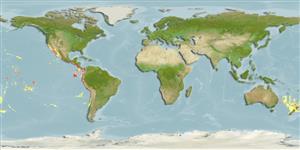>
Stomiiformes (Lightfishes and dragonfishes) >
Stomiidae (Barbeled dragonfishes) > Stomiinae
Etymology: Stomias: Greek, stoma = mouth; hard briddle (Ref. 45335).
More on author: Garman.
Environment: milieu / climate zone / depth range / distribution range
Ecología
marino batidemersal; rango de profundidad 22 - 1314 m (Ref. 95830). Deep-water
Eastern Pacific (Ref. 95830). North Atlantic and off west coast of central Africa (Ref. 27363).
Tamaño / Peso / Age
Maturity: Lm ? range ? - ? cm
Max length : 40.0 cm SL macho / no sexado; (Ref. 37473)
Short description
Claves de identificación | Morfología | Morfometría
Radios blandos dorsales (total) : 17 - 22; Radios blandos anales: 21 - 25. Body slender and black, iridescent. One tooth on each palatine (Ref. 37473).
Life cycle and mating behavior
Maturities | Reproducción | Spawnings | Egg(s) | Fecundities | Larva
Castellanos-Galindo, G.A., E.A.R. Rincon, B. Beltrán-León, C.C. Baldwin, 2006. Check list of stomiiform, aulopiform and myctophiform fishes from Colombian waters of the tropical eastern Pacific. Biota Colombiana 7(2):245-262. (Ref. 95830)
IUCN Red List Status (Ref. 130435)
Threat to humans
Harmless
Human uses
Herramientas
Special reports
Download XML
Fuentes de Internet
Estimates based on models
Preferred temperature (Ref.
123201): 7.2 - 13.8, mean 9.7 °C (based on 95 cells).
Phylogenetic diversity index (Ref.
82804): PD
50 = 0.5010 [Uniqueness, from 0.5 = low to 2.0 = high].
Bayesian length-weight: a=0.00170 (0.00072 - 0.00400), b=3.22 (3.02 - 3.42), in cm total length, based on LWR estimates for this (Sub)family-body shape (Ref.
93245).
Nivel trófico (Ref.
69278): 4.2 ±0.7 se; based on size and trophs of closest relatives
Resiliencia (Ref.
120179): Medio, población duplicada en un tiempo mínimo de 1.4-4.4 años (Preliminary K or Fecundity.).
Fishing Vulnerability (Ref.
59153): Moderate vulnerability (39 of 100).
